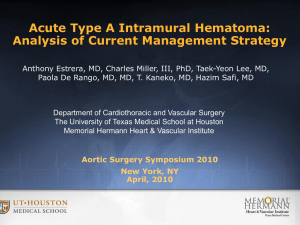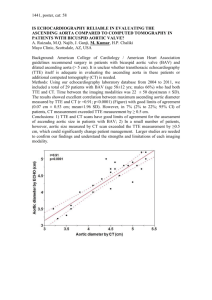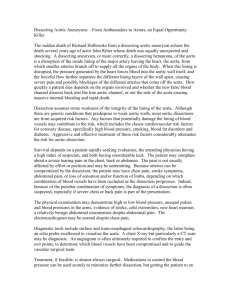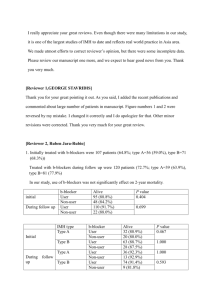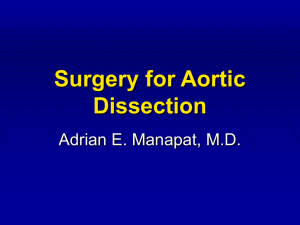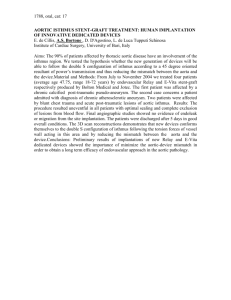PDF Links - Soonchunhyang Medical Science
advertisement
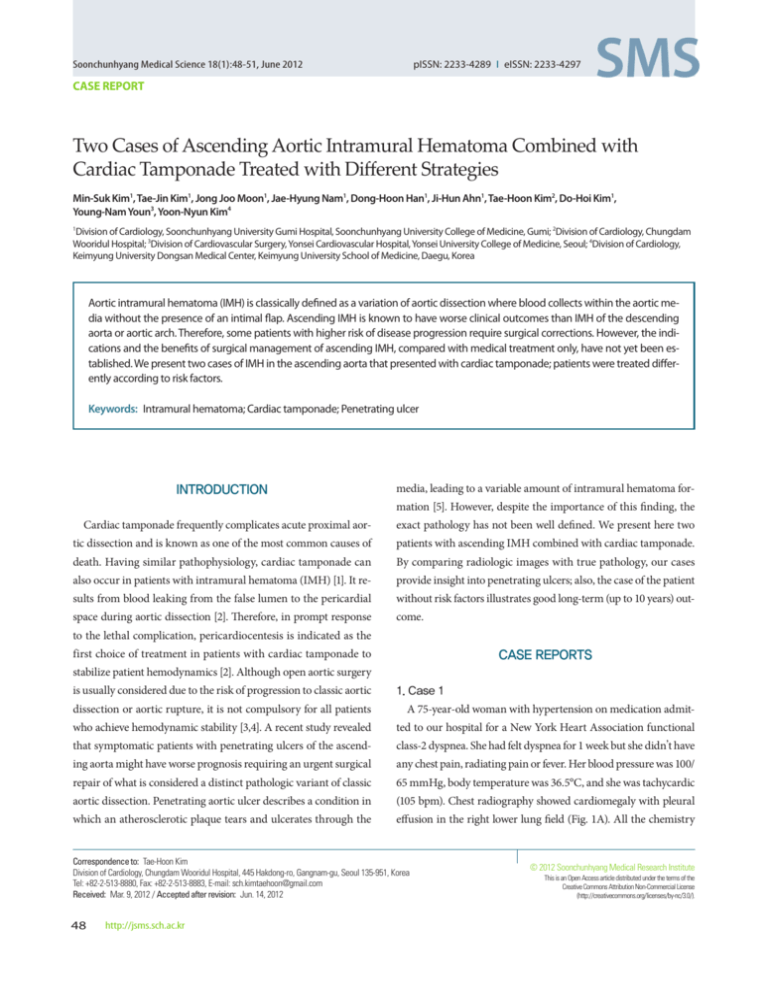
pISSN: 2233-4289 I eISSN: 2233-4297 Soonchunhyang Medical Science 18(1):48-51, June 2012 CASE REPORT Two Cases of Ascending Aortic Intramural Hematoma Combined with Cardiac Tamponade Treated with Different Strategies Min-Suk Kim1, Tae-Jin Kim1, Jong Joo Moon1, Jae-Hyung Nam1, Dong-Hoon Han1, Ji-Hun Ahn1, Tae-Hoon Kim2, Do-Hoi Kim1, Young-Nam Youn3, Yoon-Nyun Kim4 Division of Cardiology, Soonchunhyang University Gumi Hospital, Soonchunhyang University College of Medicine, Gumi; 2Division of Cardiology, Chungdam Wooridul Hospital; 3Division of Cardiovascular Surgery, Yonsei Cardiovascular Hospital, Yonsei University College of Medicine, Seoul; 4Division of Cardiology, Keimyung University Dongsan Medical Center, Keimyung University School of Medicine, Daegu, Korea 1 Aortic intramural hematoma (IMH) is classically defined as a variation of aortic dissection where blood collects within the aortic media without the presence of an intimal flap. Ascending IMH is known to have worse clinical outcomes than IMH of the descending aorta or aortic arch. Therefore, some patients with higher risk of disease progression require surgical corrections. However, the indications and the benefits of surgical management of ascending IMH, compared with medical treatment only, have not yet been established. We present two cases of IMH in the ascending aorta that presented with cardiac tamponade; patients were treated differently according to risk factors. Keywords: Intramural hematoma; Cardiac tamponade; Penetrating ulcer INTRODUCTION media, leading to a variable amount of intramural hematoma formation [5]. However, despite the importance of this finding, the Cardiac tamponade frequently complicates acute proximal aor- exact pathology has not been well defined. We present here two tic dissection and is known as one of the most common causes of patients with ascending IMH combined with cardiac tamponade. death. Having similar pathophysiology, cardiac tamponade can By comparing radiologic images with true pathology, our cases also occur in patients with intramural hematoma (IMH) [1]. It re- provide insight into penetrating ulcers; also, the case of the patient sults from blood leaking from the false lumen to the pericardial without risk factors illustrates good long-term (up to 10 years) out- space during aortic dissection [2]. Therefore, in prompt response come. to the lethal complication, pericardiocentesis is indicated as the first choice of treatment in patients with cardiac tamponade to CASE REPORTS stabilize patient hemodynamics [2]. Although open aortic surgery is usually considered due to the risk of progression to classic aortic 1. Case 1 dissection or aortic rupture, it is not compulsory for all patients A 75-year-old woman with hypertension on medication admit- who achieve hemodynamic stability [3,4]. A recent study revealed ted to our hospital for a New York Heart Association functional that symptomatic patients with penetrating ulcers of the ascend- class-2 dyspnea. She had felt dyspnea for 1 week but she didn’t have ing aorta might have worse prognosis requiring an urgent surgical any chest pain, radiating pain or fever. Her blood pressure was 100/ repair of what is considered a distinct pathologic variant of classic 65 mmHg, body temperature was 36.5°C, and she was tachycardic aortic dissection. Penetrating aortic ulcer describes a condition in (105 bpm). Chest radiography showed cardiomegaly with pleural which an atherosclerotic plaque tears and ulcerates through the effusion in the right lower lung field (Fig. 1A). All the chemistry Correspondence to: Tae-Hoon Kim Division of Cardiology, Chungdam Wooridul Hospital, 445 Hakdong-ro, Gangnam-gu, Seoul 135-951, Korea Tel: +82-2-513-8880, Fax: +82-2-513-8883, E-mail: sch.kimtaehoon@gmail.com Received: Mar. 9, 2012 / Accepted after revision: Jun. 14, 2012 48 http://jsms.sch.ac.kr © 2012 Soonchunhyang Medical Research Institute This is an Open Access article distributed under the terms of the Creative Commons Attribution Non-Commercial License (http://creativecommons.org/licenses/by-nc/3.0/). Treatment of Aortic Intramural Hematoma • Kim MS, et al. A B C D E F Fig. 1. (A) Chest posteroanterior shows cardiomegaly with right pleural effusion. (B) Transthoracic echocardiography shows the enlarged ascending aorta (Ao) with early diastolic collapse of the right ventricle. (C) Doppler mitral inflow indicates significant respiratory variation (dotted line). (D) An axial contrast enhanced computed tomography (CT) shows intramural hematoma of the ascending and descending aorta. Arrow indicates a focal irregular outpouching as a penetrating ulcer. (E) Reconstructed sagittal cross-section CT indicating high density hemorrhagic leakage through the descending aorta and the pleural space. Arrows indicate the leaked fluid. (F) Gross pathology showed the intimal tear in the ascending aorta (arrowhead). PE, pericardial effusion. laboratory values were within normal range (protein/albumin, duced to 80 bpm. Over 100,000 red blood cells were counted with 6.9/3.8 g/dL; total cholesterol, 158 mg/dL; triglyceride, 64 mg/dL; 60% in fresh form in pericardial fluid while fluid protein and albu- low density lipoprotein-cholesterol, 116 mg/dL). However, her he- min levels were similar to serum levels (protein 6.2 g/dL and albu- moglobin level was decreased to 10.4 g/dL and brain natriuretic min 3.5 g/dL in pericardial fluid versus protein 6.9 g/dL and albu- peptide was elevated to 103.5 pg/mL. Transthoracic echocardiog- min 3.8 g/dL in serum). Computed tomography (CT) was per- raphy (TTE) was immediately performed after her admission and formed to evaluate the cause of hemopericardium. The axial con- revealed a large amount of pericardial effusion with swinging heart. trast image ascending through the descending thoracic aorta re- The right atrium (RA) was not visualized from the parasternal vealed a crescentic, high attenuation material within the aortic view due to the enlarged ascending aorta (47 mm), however the wall, consistent with intramural hematoma. Also a focal bulge out right ventricle (RV) was seen collapsed until early diastole (Fig. of the ascending aorta extending beyond the intimal border was 1B). Although it was not fully estimated because of tachycardia, E seen in the axial view (Fig. 1D). A high density fluid collection was mitral flow was a significant variable of respiratory change (Fig. visualized through the descending aorta and the dependent por- 1C). Therefore, we performed pericardiocentesis on the patient via tion of the pleural space (Fig. 1E). Although the patient did not apical approach. After 1.1 L of drainage, intra-pericardial pressure complain of dyspnea after pericardial drainage, we decided to treat decreased to a normal level (from 13 to 5 mmHg) and heart rate re- this patient with an open surgery. Epicardium was adhered to the Soonchunhyang Medical Science 18(1):48-51 http://jsms.sch.ac.kr 49 Kim MS, et al. • Treatment of Aortic Intramural Hematoma A B C Fig. 2. (A) Chest radiography shows widened mediastinum and cardiomegaly. (B) An axial magnetic resonance imaging shows intramural hematoma of the ascending and descending aorta without tear sites. (C) A 10-year follow-up computed tomography shows no visible crescentic, high attenuation material within the aortic wall at the ascending or descending aorta. myocardium and the ascending aorta was also adhered to the RA. sensus about treatment of patients with uncomplicated IMH in- There was an intimal tear site on the distal part of the ascending volving only the descending aorta or the aortic arch; optimal medi- aorta (Fig. 1F). During 6-month clinical follow-up after aorta graft cal treatment is recommended for these patients [6]. However, un- replacement surgery, she showed excellent functional capacity with- til recently, the optimal treatment of ascending IMH remained out any sequelae. controversial. IMH is believed to have a more benign natural history than classic aortic dissection. However, patients with IMH showed a greater frequency of pericardial and pleural effusion, 2. Case 2 A 52-year-old man with hypertension on medication presented with a higher prevalence of cardiac tamponade at clinical presen- to the emergency department with acute chest pain. His blood tation [8]. Although the prevalence of cardiac tamponade was high- pressure was 80/60 mmHg and heart rate was 110 bpm. Chest ra- er than that in classic aortic dissection, the IMH patients present- diography showed a widened mediastinum and cardiomegaly (Fig. ing with tamponade and surviving after the pericardiocentesis 2A). The CT taken at the primary hospital revealed ascending IMH turned out to have their conditions improved during medical ther- with enhanced pericardial effusion. The emergency portable TTE apy [3,4]. Therefore, physicians must decide on further treatment revealed the collapse of RA with early diastolic collapse of RV and strategies following pericardial drainage. a large amount of pericardial effusion. After immediate pericardi- Currently, the most important markers requiring open surgery ocentesis, the patient’s vital signs stabilized. Ten days later, mag- in IMH patients seemed to be the patient’s ongoing chest pain and netic resonance imaging showed neither the visible intimal tear existence of penetrating ulcers of the ascending aorta [5]. Penetrat- site nor the residual pericardial hemorrhage (Fig. 2B). The patient ing aortic ulcer is defined by an ulceration of an aortic atheroscle- was discharged on medications including atenolol. During ten rotic plaque penetrating through the internal elastic lamina into years of follow-up, the patient has not had any chest pain. Also the the aortic media [9]. The penetrating ulcer could separate media 10-year follow-up CT showed no visible false lumen around the layers and could lead to the adjacent IMH to either a local or longi- ascending or descending aorta (Fig. 2C). tudinal progression. Our pathology assessment also demonstrated longitudinal tearing at the ascending aorta which made a true open- DISCUSSION ing through the media (Fig. 1F). For this reason, it was known as a denominator of IMH progression and an adverse outcome [7]. Many IMH, defined as aortic dissection without identifiable intimal authors believed that penetrating ulcers located at the ascending tears and lack of flow in the aorta false lumen [6], was known to aorta probably require urgent surgical repair in most patients [10, have similar natural history and prognosis to classic dissection 11]. Proximally located IMH in patients aged over 55 with over 56 and therefore was classified according to location of involvement mm of local aortic diameter was a predictor of IMH progression of the ascending or descending aorta [7]. Generally, there is con- in a multivariate analysis [7]. Despite the patient in case 1 not com- 50 http://jsms.sch.ac.kr Soonchunhyang Medical Science 18(1):48-51 Treatment of Aortic Intramural Hematoma • Kim MS, et al. plaining of ongoing pain, we decided treatment with aggressive open surgery because of the advanced patient’s age and the location of the intramural hematoma at ascending aorta, while we have medically treated the patient in case 2, and he has survived 10 years without complications. Both cases presented with cardiac tamponade resulting from hemopericardium due to an ascending IMH. Although hemodynamic stabilization was achieved after pericardiocentesis in both cases, due to the higher risks of overt dissection or rupture, one patient underwent aortic surgery and successfully survived the crisis. REFERENCES 1. Estrera A, Miller C 3rd, Lee TY, De Rango P, Abdullah S, Walkes JC, et al. Acute type A intramural hematoma: analysis of current management strategy. Circulation 2009;120(11 Suppl):S287-91. 2. Isselbacher EM, Cigarroa JE, Eagle KA. Cardiac tamponade complicating proximal aortic dissection. Is pericardiocentesis harmful? Circulation 1994;90:2375-8. 3. Shimizu H, Yoshino H, Udagawa H, Watanuki A, Yano K, Ide H, et al. Soonchunhyang Medical Science 18(1):48-51 Prognosis of aortic intramural hemorrhage compared with classic aortic dissection. Am J Cardiol 2000;85:792-5, A10. 4. Kaji S, Nishigami K, Akasaka T, Hozumi T, Takagi T, Kawamoto T, et al. Prediction of progression or regression of type A aortic intramural hema­ toma by computed tomography. Circulation 1999;100(19 Suppl):II281-6. 5. Coady MA, Rizzo JA, Hammond GL, Pierce JG, Kopf GS, Elefteriades JA. Penetrating ulcer of the thoracic aorta: what is it? How do we recognize it? How do we manage it? J Vasc Surg 1998;27:1006-15. 6. Evangelista A, Mukherjee D, Mehta RH, O’Gara PT, Fattori R, Cooper JV, et al. Acute intramural hematoma of the aorta: a mystery in evolution. Circulation 2005;111:1063-70. 7. Nienaber CA, Richartz BM, Rehders T, Ince H, Petzsch M. Aortic intramural haematoma: natural history and predictive factors for complications. Heart 2004;90:372-4. 8. Song JK, Yim JH, Ahn JM, Kim DH, Kang JW, Lee TY, et al. Outcomes of patients with acute type a aortic intramural hematoma. Circulation 2009; 120:2046-52. 9. Stanson AW, Kazmier FJ, Hollier LH, Edwards WD, Pairolero PC, Sheedy PF, et al. Penetrating atherosclerotic ulcers of the thoracic aorta: natural history and clinicopathologic correlations. Ann Vasc Surg 1986;1:15-23. 10. Erbel R, Alfonso F, Boileau C, Dirsch O, Eber B, Haverich A, et al. Diagnosis and management of aortic dissection. Eur Heart J 2001;22:1642-81. 11. Eggebrecht H, Baumgart D, Schmermund A, Herold U, Hunold P, Jakob H, et al. Penetrating atherosclerotic ulcer of the aorta: treatment by endovascular stent-graft placement. Curr Opin Cardiol 2003;18:431-5. http://jsms.sch.ac.kr 51

